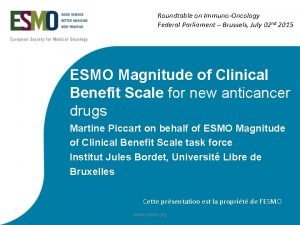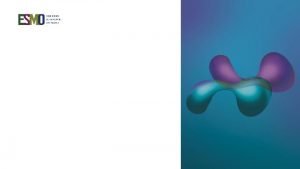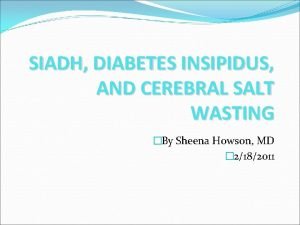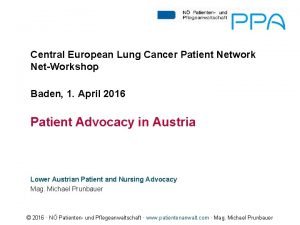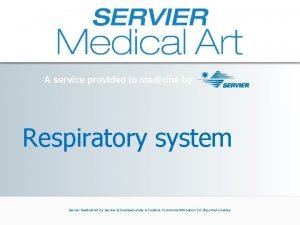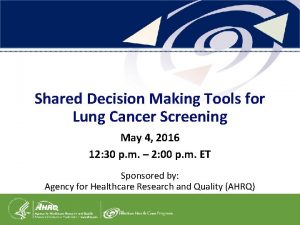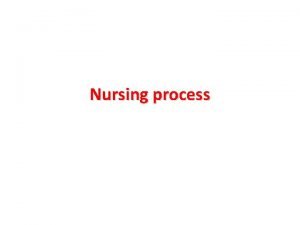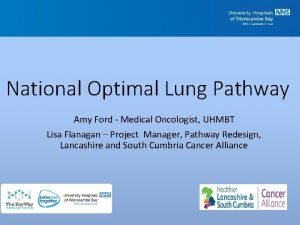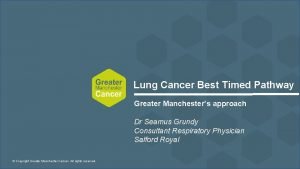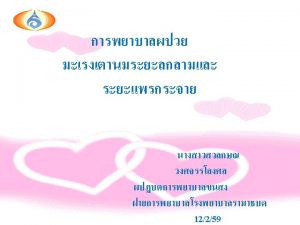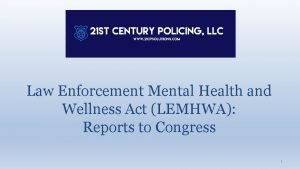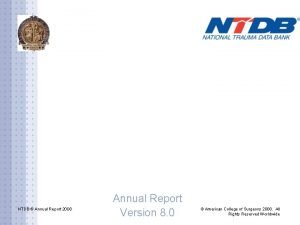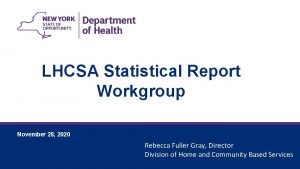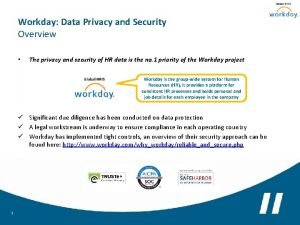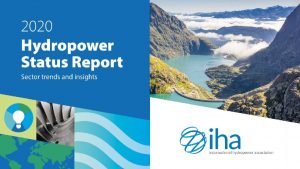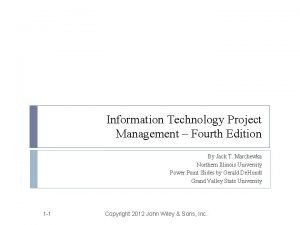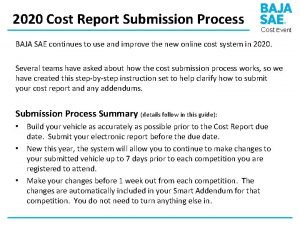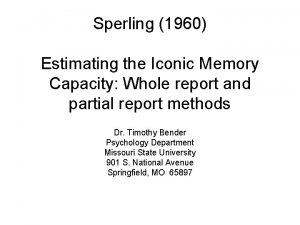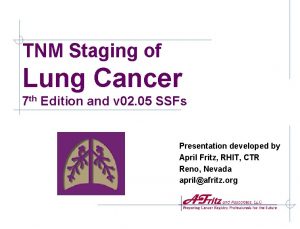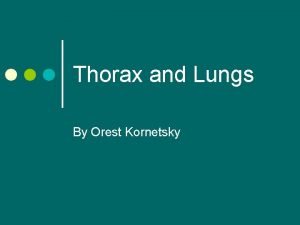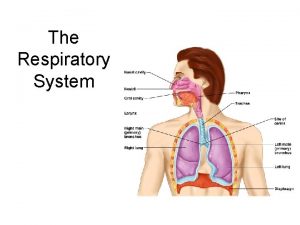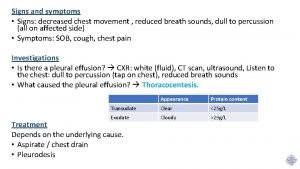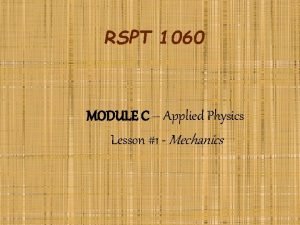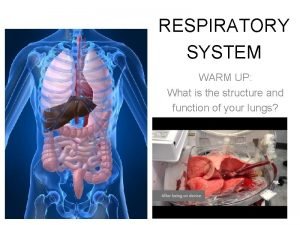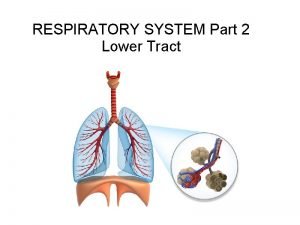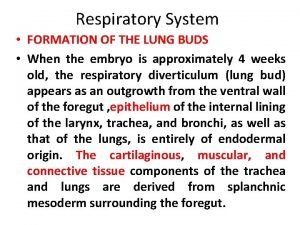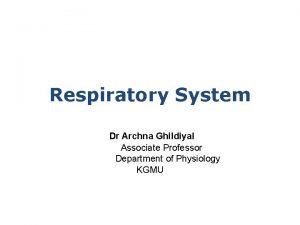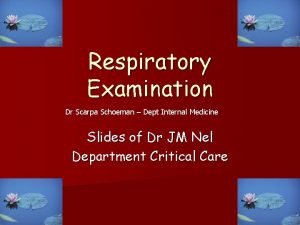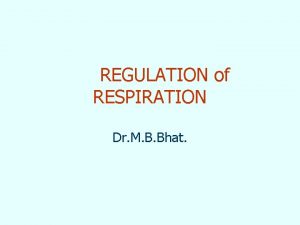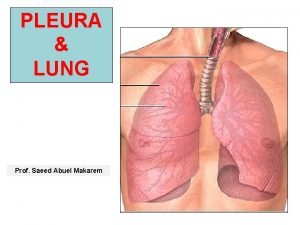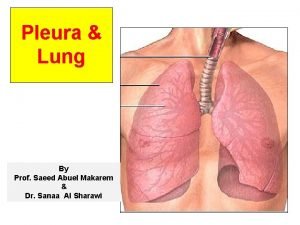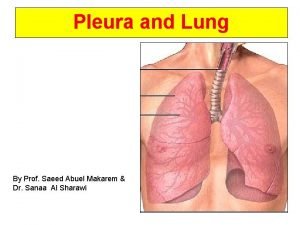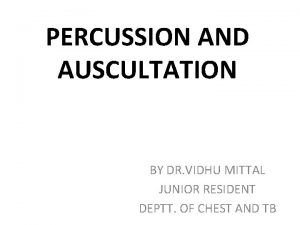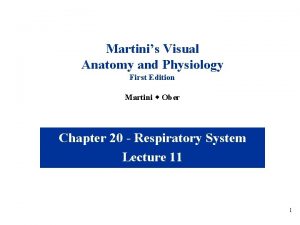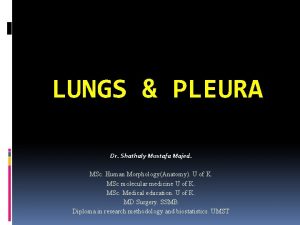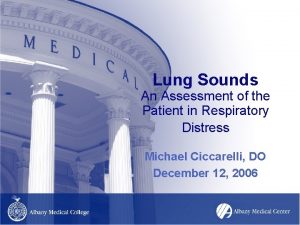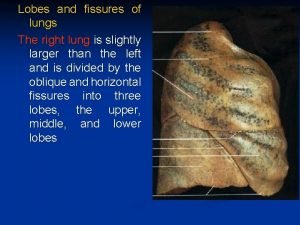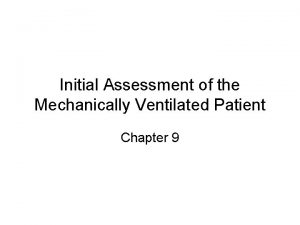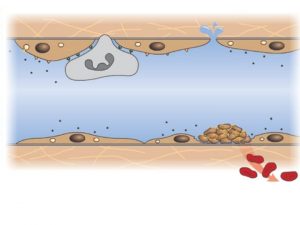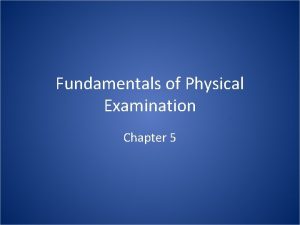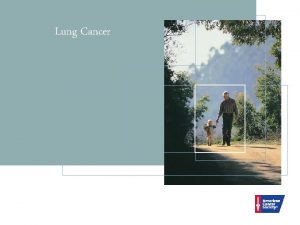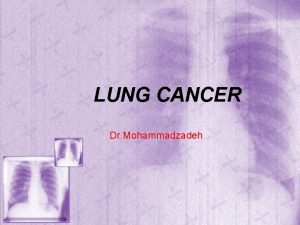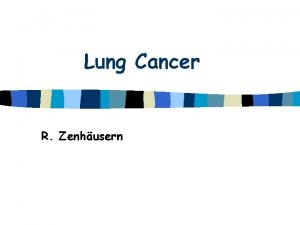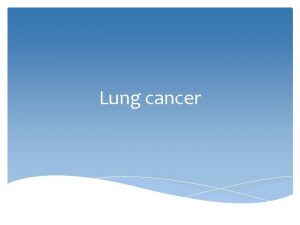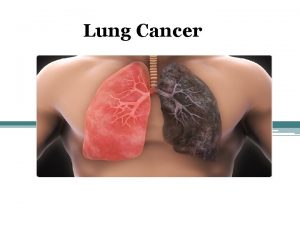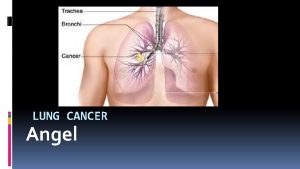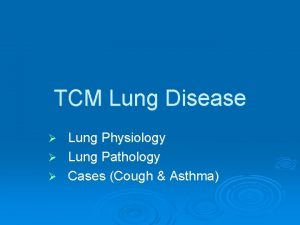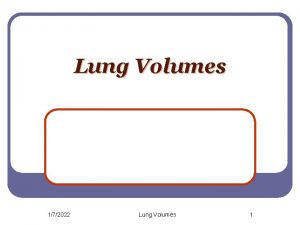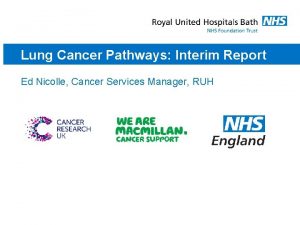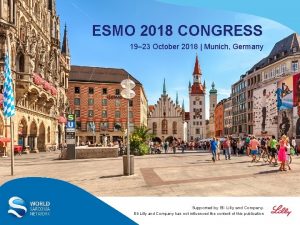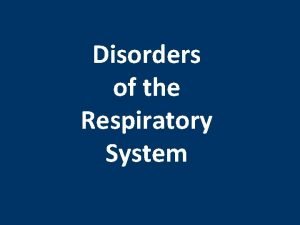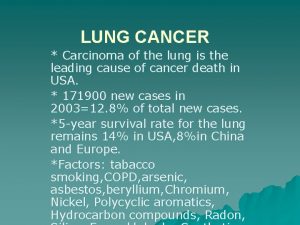ESMO 2020 Virtual Congress Report Lung cancer PD1PDL


























































- Slides: 58

ESMO 2020 (Virtual) Congress Report Lung cancer: PD-1/PD-L 1 inhibition and PARP inhibition in NSCLC

Contents Slide numbers Contents 3 Introduction to PD-1/PD-L 1 inhibition and PARP inhibition in NSCLC 4 -11 KEYNOTE-033: Randomized, open-label phase 3 study of pembrolizumab vs docetaxel in patients with previously treated NSCLC with PD-L 1 tumor proportion score (TPS) ≥ 1%. 12 -18 KEYNOTE-024: Randomized open-label phase 3 trial of pembrolizumab vs platinum-based chemotherapy in 1 L subjects with PD-L 1 strong metastatic NSCLC: 5 -year OS update 19 -24 JASPER: Efficacy and safety of 1 L niraparib plus a PD-1 inhibitor (nivolumab) in patients with advanced NSCLC. 25 -31 EMPOWER-lung 1: Randomized, open-label, multi-national, phase 3 trial of cemiplimab, a human PD-1 monoclonal antibody, vs chemotherapy in 1 L treatment of advanced NSCLC with PD-L 1 50%. 32 -40 RATIONALE 304: Tislelizumab plus chemotherapy vs chemotherapy alone as first-line treatment for locally advanced/metastatic nonsquamous NSCLC. 41 -50 RATIONALE 307: Updated analysis of tislelizumab plus chemotherapy vs chemotherapy alone as first-line treatment of advanced squamous NSCLC. 51 -58 TASUKI-52: Randomized phase 3 trial of nivolumab in combination with carboplatin, paclitaxel, and bevacizumab as first-line treatment for patients with advanced or recurrent non-squamous NSCLC. 59 Abbreviations PD-1: Programmed cell death protein-1. PD-L 1: Programmed death ligand 1. N SCLC: Non-small cell lung cancer. 1 L: First line. OS: Overall survival.

Introduction to PD-1/PD-L 1 and PARP inhibition in NSCLC Global estimation of over 2 million new lung cancer cases and 1. 8 million deaths occurring annually of which around 90% of all cases are NSCLC Recently, PD-1 inhibitor in combination with chemotherapy have been approved in some countries as firstline treatment for advanced NSCLC Platinum-based regimens remain standard first-line therapy for patients who have no access to checkpoint inhibitors Overall survival remains low for patients with advanced NSCLC treated with platinum-based therapies, leaving considerable room for improvement of patient outcomes Combination of PARP inhibition with PD-1/PD-L 1 inhibition may enhance antitumour activity of immune checkpoint inhibitors PD-1: Programmed cell death protein-1. PD-L 1: Programmed death ligand 1. PARP: Poly (ADP-ribose) polymerase. NSCLC: Non-small cell lung cancer. OS: Overall survival. 1. Lu, S. et al. 2020. Poster 1263 P presented at ESMO 2020. 2. Wang et al, 2020. Poster presented at ESMO 2020

KEYNOTE-033 PD-1 inhibitor pembrolizumab vs docetaxel in patients with previously treated NSCLC with PD-L 1 tumor proportion score (TPS) ≥ 1%

KEYNOTE-033 Study design and objectives Multi-country, randomized, open-label phase 3 study of pembrolizumab vs docetaxel in patients with previously treated NSCLC with PD-L 1 tumor proportion score (TPS) ≥ 1% Total of 425 patients enrolled, with the majority (73. 2%) from mainland China Key eligibility criteria • Advanced NSCLC (histologically or cytologically confirmed stage 3 b/4 or recurrent NSCLC; ≥ 1 measurable lesion by RECIST 1. 1) • Confirmed PD after ≥ 1 line of platinum-containing chemotherapy* • ECOG PS 0 -1 • PD-L 1 TPS ≥ 1% • No active CNS metastases or autoimmune disease • No pneumonitis requiring systemic steroids Pembrolizumab 2 mg/kg IV Q 3 W (up to 35 cycles**) N=213 R 1: 1 Docetaxel 75 mg/m 2 IV Q 3 W per local standard of care N=212 Treatment for specified number of cycles or until confirmed disease progression, intolerable toxicity, patient withdrawal, or physician decision *Prior therapy must have included ≥ 2 cycles of platinum-doublet chemotherapy. An ALK-directed tyrosine kinase inhibitor was required for patients whose tumors had an ALK translocation. **Some patients may be eligible to enter a Second Course Phase of the trial for up to 17 cycles of treatment with pembrolizumab. Objectives • • Compare OS, progression-free survival (PFS), objective response rate (ORR), and duration of response (DOR) of pembrolizumab vs docetaxel for patients with previously treated, PD-L 1 expressing advanced NSCLC Evaluate the safety and tolerability profiles of pembrolizumab and docetaxel for patients with previously treated, PDL 1 -expressing advanced NSCLC: Non small cell lung cancer. CNS: Central nervous system. ECOG PS: Eastern Cooperative Oncology Group Performance Status. ICR: Independent central review. IV: Intravenous. PD: Progressive disease. Q 3 W: every 3 weeks. RECIST: Response Evaluation Criteria in Solid Tumors. TPS: Tumor proportion score. OS: Overall survival. PFS: Progression free survival. DOR: Duration of response. Zhou, C. et al, 2020. Poster 1262 P presented at ESMO 2020.

KEYNOTE-033 Results – efficacy in total population Kaplan-Meier estimates of OS 100 90 80 70 60 50 40 30 20 10 0 Events HR (95% CI) Pembrolizumab 67. 5% 0. 83 (0. 61 -1. 14) Docetaxel 70. 8% 12 -mo rate 51. 7% 47. 3% 0 3 No. at risk 114 100 113 94 24 -mo rate 25. 1% 22. 4% 9 12 15 18 21 24 27 30 33 86 80 71 61 57 51 39 27 25 18 17 12 10 5 5 1 0 0 Pembrolizumab vs docetaxel • 1. 4 month improvement in median OS • 12 -month OS 51. 7% vs 47. 3% • 24 -month OS 25. 1% vs 22. 4% a. One-sided pa 0. 1276 Median (95% CI) 12. 3 mo (10. 0 -16. 3) 10. 9 mo (8. 3 -13. 1) 6 Time, months PD-L 1 TPS ≥ 1% OS, % PD-L 1 TPS ≥ 50% Because statistical significance for the TPS ≥ 50% population was not achieved, all sequential testing ceased 100 90 80 70 60 50 40 30 20 10 0 Events HR (95% CI) Pembrolizumab 63. 8% 0. 75 (0. 60 -0. 95) Docetaxel 73. 1% 12 -mo rate 52. 0% 46. 9% 0 3 6 9 12 24 -mo rate 29. 4% 19. 0% 15 18 21 24 27 30 33 76 51 50 33 34 19 16 7 6 1 0 0 Time, months No. at risk 213 186 159 131 105 212 180 146 117 94 Pembrolizumab vs docetaxel • 2. 3 month improvement in median OS • 12 -month OS 52. 0% vs 46. 9% • 24 -month OS 29. 4% vs 19. 0% P value based on log-rank test. CI, confidence interval. HR, hazard ratio. OS: Overall survival. TPS: Tumor proportion score. Zhou, C. et al, 2020. Poster 1262 P presented at ESMO 2020. Median (95% CI) 12. 9 mo (10. 3 -16. 5) 10. 6 mo (8. 7 -12. 5)

KEYNOTE-033 Results - efficacy in total population Kaplan-Meier estimates of PFS per RECIST v 1. 1 by BICR PD-L 1 TPS ≥ 50% 90 80 12 -mo rate 33. 7% 9. 0% PFS, % 70 60 24 -mo rate 21. 9% 9. 0% Median (95% CI) 4. 0 mo (2. 1 -8. 0) 2. 5 mo (2. 1 -4. 2) 50 40 30 20 10 0 0 3 6 9 12 PD-L 1 TPS ≥ 1% Events HR (95% CI) Pembrolizumab 62. 3% 0. 76 (0. 54 -1. 07) Docetaxel 60. 2% 15 18 21 24 27 30 33 7 1 4 1 1 0 0 0 PFS, % 100 90 80 70 60 50 40 30 20 10 0 12 -mo rate 28. 4% 15. 4% 0 3 6 9 58 32 42 8 Time, months No. at risk 114 49 113 38 34 18 25 3 23 2 14 1 9 1 Pembrolizumab vs docetaxel • 12 -month PFS 33. 7% vs. 9. 0% • 24 -month PFS 21. 9% vs 9. 0% • 1. 5 month improvement in median PFS Events HR (95% CI) Pembrolizumab 64. 8% 0. 84 (0. 66 -1. 08) Docetaxel 58. 0% No. at risk 213 86 212 72 12 24 -mo rate 18. 0% 15. 4% 15 18 21 24 27 30 33 13 2 11 1 6 1 1 0 0 0 Time, months 36 4 22 2 Median (95% CI) 3. 3 mo (2. 1 -4. 1) 3. 0 mo (2. 3 -4. 0) Pembrolizumab vs docetaxel • 12 -month PFS 28. 4% vs 15. 4% • 24 -month PFS 18. 0% vs 15. 4% • 0. 3 month improvement in median PFS BICR: Blinded independent central review. CI, confidence interval. HR, hazard ratio. PFS: Progression free survival. RECIST: Response Evaluation Criteria in Solid Tumors. TPS: Tumor proportion score. Zhou, C. et al, 2020. Poster 1262 P presented at ESMO 2020.

KEYNOTE-033 Results – efficacy in total population Confirmed ORR and DOR per RECIST v 1. 1 by BICR Pembrolizumab TPS ≥ 50% ORR (95% CI), % Ongoing responses*, N (%) Median DOR (range)**, months TPS ≥ 1% ORR (95% CI), % Ongoing responses*, N (%) Median DOR (range)**, months Docetaxel N=114 N=113 28. 1 (20. 1 -37. 3) 7. 1 (3. 1 -13. 5) 16 (50. 0) 1 (12. 5) 16. 6 (1. 1+-24. 9+) 6. 4 (1. 4+-22. 3) N=213 N=212 20. 7 (15. 4 -26. 7) 5. 7 (3. 0 -9. 7) 21 (47. 7) 1 (8. 3) 16. 6 (1. 1+-24. 9+) 6. 3 (1. 4+-22. 3) Pembrolizumab vs docetaxel ORR • 21% improvement in TPS ≥ 50% population • 15% improvement in TPS ≥ 1% population Median DOR • 10. 2 months improvement in TPS ≥ 50% population • 10. 3 months improvement in TPS ≥ 1% population *Includes patients who were alive, had not progressed, had not initiated new anticancer treatment, were not lost to followup, and whose last disease assessment was <5 months prior to data cutoff date. **Includes patients with confirmed complete response or partial response. From product-limit (Kaplan-Meier) method for censored data. ORR: Objective response rate. DOR: Duration of response. RECIST: Response Evaluation Criteria in Solid Tumors. BICR: Blinded independent central review. TPS: Tumor proportion score. CI: Confidence interval. Zhou, C. et al, 2020. Poster 1262 P presented at ESMO 2020.

KEYNOTE-033 Results – efficacy in mainland China population OS, % Kaplan-Meier estimates of OS in patients with PD-L 1 TPS ≥ 1% 100 90 80 70 60 50 40 30 20 10 0 Events HR (95% CI) Pembrolizumab 59. 9% 0. 68 (0. 51 -0. 89) Docetaxel 71. 1% 12 -mo rate 58. 6% 44. 5% 24 -mo rate 32. 2% 21. 3% Median (95% CI) 15. 0 mo (12. 2 -17. 9) 9. 6 mo (8. 0 -12. 5) OS, PFS, and ORR in Patients From Mainland China Pembrolizumab TPS ≥ 1% OS PFS ORR Median (95% CI), months 0 3 6 9 No. at risk 162 142 126 110 149 126 99 79 12 15 18 21 Time, months 89 61 66 39 43 26 29 14 24 12 5 27 4 1 30 0 0 Pembrolizumab vs docetaxel • 12 -month OS 58. 6% vs 44. 5% • 24 -month OS 32. 2% vs 21. 3% • 5. 4 months improvement in median OS 33 0 0 PFS ORR N=149 15. 0 (12. 2 -17. 9) 9. 6 (8. 0 -12. 5) 0. 68 (0. 51 -0. 89) 4. 0 (2. 2 -8. 0) HR (95% CI) % (95% CI) TPS ≥ 50% OS N=162 HR (95% CI) Median (95% CI), months HR (95% CI) % (95% CI) Pembrolizumab vs docetaxel OS • 5. 4 months improvement in TPS ≥ 1% population • 2. 6 months improvement in TPS ≥ 50% population PFS • 1. 7 months improvement in TPS ≥ 1% population • 1. 9 months improvement in TPS ≥ 50% population ORR • 23. 5% vs 6. 0% in TPS ≥ 1% population • 31. 0% vs 8. 5% in TPS ≥ 50% population Ci, confiidence interval. HR, hazard ratio. PFS: Progression-free survival. ORR: Objective response rate. OS: Overall survival. TPS: Tumor proportion score. Zhou, C. et al, 2020. Poster 1262 P presented at ESMO 2020. Docetaxel 2. 3 (2. 1 -3. 4) 0. 74 (0. 55 – 0. 99) 23. 5 (17. 2 -30. 7) 6. 0 (2. 8 -11. 2) N=86 N=82 13. 2 (10. 2 -17. 0) 10. 6 (7. 1 -13. 1) 0. 79 (0. 55 -1. 13) 4. 2 (2. 1 -8. 4) 2. 3 (2. 1 -4. 0) 0. 74 (0. 49 -1. 10) 31. 0 (21. 5 – 41. 9) 8. 5 (3. 5 -16. 8)

KEYNOTE-033 Results – safety and tolerability Summary of treatment-related adverse events (TRAEs*) in all treated patients N (%) Any grade** Grade 3 -5 Led to discontinuation Led to death Pembrolizumab (N=213) 149 (70. 0) 24 (11. 3) 21 (9. 9) 4 (1. 9) Docetaxel (N=198) 174 (87. 9) 94 (47. 5) 15 (7. 6) 4 (2. 0) *AEs were followed 30 days after the last dose of study treatment. **Grades were based on National Cancer Institute Common Terminology Criteria for Adverse Events. Version 4. 03. Incidence of immune-mediated AEs and infusion reactions observed in ≥ 2 patients in the pembrolizumab arm in the PD-L 1 TPS ≥ 1% population TRAEs with incidence ≥ 15% in any arm, PD-L 1 TPS ≥ 1% Grade 1 -2 Pembrolizumab Docetaxel 50 45 40 Grade ≥ 3 14 12 Patients, % 35 30 25 20 15 Grade ≥ 3 10 8 6 4 10 2 5 0 Grade 1 -2 Pembrolizumab Docetaxel 0 AST Rash Anemia Fatigue Appetite WBC Leukopenia Alopecia Neutropenia 0 Hypothyroidism 0 Pneumonitis Hypethyroidism TRAE: Treatment related adverse event. TPS: Tumor proportion score. AST: Aspartate aminotransferase. WBC: white blood cell count. AE: Adverse event. Zhou, C. et al, 2020. Poster 1262 P presented at ESMO 2020. 0 Infusion reactions Hepatitis Nephritis 0 Severe skin reactions

KEYNOTE-033 Conclusions • In this population of patients with previously treated advanced NSCLC, pembrolizumab did not significantly prolong OS in the PD-L 1 TPS ≥ 50% population o HRs for OS and PFS numerically favored pembrolizumab in both the TPS ≥ 50% and TPS ≥ 1% populations o Pembrolizumab was associated with higher ORR and longer DOR in both TPS populations o Similar efficacy benefits were also observed in patients from mainland China • Safety/tolerability was consistent with the established pembrolizumab safety profile o Despite longer follow-up and longer treatment exposure with pembrolizumab, rates of any-grade and grade 3 -5 treatment-related AEs, especially hematological AEs, remained lower with pembrolizumab vs docetaxel o Pembrolizumab was well tolerated in the patient population with NSCLC predominantly from mainland China • These data support the use of pembrolizumab for patients with previously treated advanced NSCLC in China NSCLC: Non small cell lung cancer. OS: Overall survival. HR: Harzard ratio. PFS: Progression free survival. TPS: Tumor proportion score. DOR: Duration of response. AE: adverse event. Zhou, C. et al, 2020. Poster 1262 P presented at ESMO 2020

KEYNOTE-024 PD-1 inhibitor pembrolizumab (1 L) vs platinum based chemotherapy in metastatic NSCLC with PD-L 1 tumor proportion score (TPS) ≥ 50%: 5 -Year OS update

KEYNOTE-024 Study design First-line (1 L) pembrolizumab vs platinum-based chemotherapy in patients with metastatic NSCLC and PD-L 1 tumour proportion score (TPS) ≥ 50%: 5 -year overall survival (OS) update Second course pembrolizumab*** Key eligibility criteria • • Pembrolizumab 200 mg IV Q 3 W 35 cycles (2 years) Untreated stage IV NSCLC PD-L 1 TPS ≥ 50% ECOG performance status 0 -1 No activating EGFR mutations or ALK translocation Pembrolizumab 200 mg Q 3 W 17 cycles (1 year) R 1: 1 N=305 Crossover pembrolizumab Platinum doublet chemotherapy* (4 -6 cycles) • No untreated brain metastases • No active autoimmune disease requiring systemic therapy • • • PD **** Pembrolizumab 200 mg Q 3 W (2 years) Primary endpoint: PFS (RECIST v 1. 1 per BICR) Key secondary endpoint: OS Other secondary endpoints: ORR, safety, PFS (RECIST v 1. 1, per investigator review) Exploratory endpoint: DOR Pemetrexed + carboplatin** Pemetrexed + cisplatin** Paclitaxel + carboplatin Gemcitabine + cisplatin *Optional pemetrexed maintainance therapy for nonsquamous disease. **Permitted for nonsqaumous disease only. ***Patients randomized to pembrolizumab who completed 2 years of therapy or who stopped pembrolizumab after achieving CR and then had PD were eligible for a second course of Pembrolizumab monotherapy. ****Before the DMC recommendadtion and amendment 8, which permitted those in the chemotherapy arm to be offered pembrolizumab (based on interim analysis of phase 2 data) patients were eligible for crossover when PD was confirmed by BICR. NSCLC: Non small cell lung cancer. OS: Overall survival. ECOG: Eastern Cooperative Oncology Group. PFS: Progression free survival. ORR: Objective response rate. RECIST: Response Evaluation Criteria in Solid Tumors. Q 3 W: Every 3 weeks. R: Randomization. IV: Intravenous. BICR: Blinded independent central review. CR: Complete reponse. PD: Progressive disease. DOR: Duration of response Brahmer, J. et al, 2020. Abstract LBA 51 presented at ESMO 2020

KEYNOTE-024 Results - efficacy Overall survival (ITT population) 100 90 Overall survival, % N Median (95% CI) 26. 3 mo (18. 3– 40. 4 mo) 13. 4 mo (9. 4– 18. 3 mo) 80 70 60 Pembrolizumab 154 Events, N (%) 103 (66. 9) Chemotherapy* 151 123 (81. 5) 43. 7% 24. 7% 50 40 HR (95% CI) 0. 62 (0. 48– 0. 81) • 35. 8% 19. 8% 31. 9% 16. 3% • 30 20 10 0 0 6 12 18 24 30 36 42 • 48 54 60 66 72 54 28 51 26 20 13 0 0 Median OS almost double in pembrolizumab arm vs chemotherapy arm (26. 3 months vs 13. 4 months, HR 0. 62) Benefit seen despite 66% crossover rate from chemotherapy to pembrolizumab 5 -year OS almost double in pembrolizumab arm vs chemotherapy arm (31. 9% vs 16. 3%) Time, months No. at risk 154 121 151 108 106 80 89 61 78 48 73 44 66 35 62 33 *Effective crossover rate from chemotherapy to aniti-PD-(L)1 therapy, 66. 0% (99 patients in total crossed over to anti-PD-(L)1 therapy: 83 patients crossed over to pembrolizumab during the study, and 16 patients received subsequent anti-PD-(L)1 therapy outside of crossover; pateints may have received >1 subsequent anti-PD-(L)1 therapy). Data cutoff: 1 st June 2020. ITT: Intention to treat. OS: Overall survival. HR: Hazard ratio. CI: Confidence interval. Brahmer, J. et al, 2020. Abstract LBA 51 presented at ESMO 2020

KEYNOTE-024 Results - efficacy Progression-free survival (ITT population) by RECIST v 1. 1 per investigator review* Progression free survival, % 100 N Median (95% CI) 7. 7 mo (6. 1– 10. 2 mo) 5. 5 mo (4. 2– 6. 2 mo) 90 80 70 Pembrolizumab 154 Events, N (%) 126 (81. 8) Chemotherapy 151 141 (93. 4) HR (95% CI) 0. 50 (0. 39– 0. 65) • • 60 50 40 22. 8% 4. 1% 30 Median PFS improvemet 2. 2 months in pembrolizumab arm vs chemotherapy arm (7. 7 months vs 5. 5 months, HR 0. 50) 3 -year PFS 18. 7% higher in pembrolizumab arm vs chemotherapy arm (22. 8% vs 4. 1%) 20 10 0 0 6 12 18 24 30 36 42 48 54 60 66 20 1 15 1 3 0 0 0 Time, months No. at risk 154 92 151 73 62 20 46 6 38 5 36 4 30 3 24 2 *Secondary endpoint; primary endpoint was PFS assessed per BICR. Data cutoff: 1 st June 2020. ITT: Intention to treat. PFS: Progression free survival. BICR: Blinded independent central review. HR: Hazard ratio. CI: Confidence interval. RECIST: Response Evaluation Criteria in Solid Tumors Brahmer, J. et al, 2020. Abstract LBA 51 presented at ESMO 2020

KEYNOTE-024 Results - efficacy Objective response rate (ITT population) by RECIST v 1. 1 per investigator review Pembrolizumab (N=154) Chemotherapy (N=151) Objective response, N (%) 71 (46. 1) 47 (31. 1) Best objective response, N (%) CR PR SD PD NE NA 7 (4. 5) 64 (41. 6) 37 (22. 7) 35 (22. 7) 0 (0) 11 (7. 1) 0 47 (31. 1) 60 (39. 7) 25 (16. 6) 1 (0. 7) 18 (11. 9) Time to response, median (range), months 2. 1 (1. 4 -14. 6) 2. 1 (1. 1 -12. 2) DOR, median (range), months 29. 1 (2. 2 -60. 8+) 6. 3 (3. 1 -52. 4) • • Median ORR 15% higher in pembrolizumab arm vs chemotherapy arm (46. 1% vs 31. 1%) 7 complete responses (CRs) in pembrolizumab arm vs 0 in chemotherapy arm Median time to response 2. 1 months for both arms Median DOR 22. 8 months longer in pembrolizumab arm vs chemotherapy arm (29. 1 months vs 6. 3 months) +Indicates response duration is censored ORR: Objective reposonse rate. ITT: Intention to treat. RECIST: Response evaluation criteria in solid tumors. CR: Complete response. PR: Progressive disease. SD: Stable disease. PD: Progressive disease. NE: Not evaluable. NA: No assessment. DOR: Duration of response. Brahmer, J. et al, 2020. Abstract LBA 51 presented at ESMO 2020

KEYNOTE-024 Results - safety and tolerability Summary of adverse events Pembrolizumab* (N=154) Chemotherapy* (N=151) 35 Cycles (2 years) of Pembrolizumab* (N=39) TRAEs, N (%) 118 (76. 6) 135 (90. 0) 34 (87. 2) Grade 3 -5** Serious Led to discontinuation Led to death 48 (31. 2) 35 (22. 7) 21 (13. 6) 2 (1. 3) 80 (53. 3) 31 (20. 7) 16 (10. 7) 3 (2. 0) 6 (15. 4) 4 (10. 3) 0 0 Immune-mediated AEs and infusion reactions, N (%)*** Grade 3 -5 Led to death 53 (34. 4) 8 (5. 3) 12 (30. 8) 21 (13. 6) 1 (0. 7) 0 3 (7. 7) 0 *During treatment with the initially assigned thearpy. **7 additional patients in the pembrolizumab arm and no additional patients in the chemotherapy arm had treatment related grade 3 -5 AEs since the initial publication of KEYNOTE-024 (Reck, M. et al. NEJM. 2016; 375: 1823 -1833). There was no change since the updated analysis at 25. 2 months median follow up (Reck, M. et al. J Clin Oncol. 2019; 37: 537 -546). ***Irrespective of attribution to treatment by the investigator. Data cutoff: 1 st June 2020. TRAE: Treatment related adverse event. AE: Adverse event. ITT: Intention to treat. Brahmer, J. et al, 2020. Abstract LBA 51 presented at ESMO 2020 • Exposure-adjusted AE rates in the ITT population decreased over time in both treatment groups

KEYNOTE-024 Conclusions • • With 5 years follow-up, pembrolizumab continues to show meaningful improvements in OS and durable responses versus chemotherapy in KEYNOTE-024 o Despite 66% effective crossover rate, the 5 -year OS rate was approximately doubled in pembrolizumab arm vs chemotherapy arm (31. 9% vs 16. 3%) with median DOR of 29. 1 months in pembrolizumab arm Patients who completed 35 cycles (2 years) of pembrolizumab experienced long-term OS o Second-course pembrolizumab at the time of disease progression was feasible and associated with antitumor activity Incidence of any-grade and grade 3 -5 TRAEs was lower with pembrolizumab versus chemotherapy o Long term treatment with pembrolizumab did not identify new safety signals KEYNOTE-024 is the first phase 3 study to demonstrate 5 -year efficacy for 1 L immunotherapy and demonstrates that pembrolizumab monotherapy is an effective 1 L treatment regimen in patients with metastatic NSCLC and PD-L 1 TPS ≥ 50% o These data confirm 5 -year OS outcomes among previously untreated patients in the single-arm KEYNOTE 001 study* *Garon EB et al. J Clin Oncol 2019; 37: 2518 -2527. OS: Overall survival. TRAE: Treatment related adverse events. 1 L: First line. NSCLC: Non small cell lung cancer. TPS: Tumor proportion score. Brahmer, J. et al, 2020. Abstract LBA 51 presented at ESMO 2020

JASPER PARPi inhibitor niraparib + PD-1 inhibitor pembrolizumab in NSCLC

JASPER Study design Multicenter, 2 cohort , open-label, proof-of-concept Phase 2 study of the combination of niraparib and PD-1 i in chemotherapy-naïve and PD-(L)1 i-naïve patients with metastatic or locally advanced NSCLC Cohort 1 (niraparib + pembrolizumab) PD-L 1 TPS ≥ 50 Cohort 2 (niraparib + pembrolizumab) PD-L 1 TPS 1 -49 Primary endpoint ORR, investigator assessed per RECIST v 1. 1 Secondary endpoints DOR, PFS, OS, safety Cycle 1 All Patients received Niraparib 200 mg POQD and pembrolizumab 200 mg IV Q 3 W Day 1 Screening* Metastatic or locally advanced NSCLC • ≥ 18 years of age • Chemotherapy naïve • PD-(L)1 inhibitor naïve • Measurable disease per RECIST v 1. 1 • Stage IIIB/IV NSCLC • No known EGFRsensitizing mutations, ALK or ROS 1 translocations • ECOG PS 0 -1 • PD-L 1 expression (TPS) available Treatment period Day 8 Day 15 Day 21 Safety assessments: Day 1, 8, 15 of Cycle 1; Day 1 of all subsequent cycles Tumour assessments: 9 w after first dose; Q 9 W until Week 72; Q 12 W thereafter Efficacy analysis m. ITT population: Received any study drug and did not withdraw consent prior to having ≥ 1 postbaseline tumor assessment** Safety analysis Received ≥ 1 dose of study treatment EOT period‡ Safety assessments: 30 + 7 d after EOT; follow-up assessment every 90 ± 14 d Tumor assessments§: Q 9 W until week 72; Q 12 W thereafter Statistical analysis Sample size calculated for each cohort based on primary endpoint of ORR; SAS software v 9. 4 Objective: To report interim data on the efficacy and safety of the combination of niraparib and pembrolizumab in patients with PD-L 1 TPS ≥ 50% (Cohort 1) and PD-L 1 TPS 1– 49% (Cohort 2) *Includes initial safety monitoring and baseline tumor assessment; scans performed as part of routine clinical management are acceptable for use as initial tumor imaging if they are of diagnostic quality and performed within 28 days prior to first dose date; †until discontinuation due to death, progressive disease, unacceptable toxicity, severe noncompliance with the protocol, withdrawal of consent, pregnancy, confirmed CR in patient who has >24 w of treatment and 2 cycles after CR confirmed, or study termination; ‡until death or end of study data collection (minimum 6 months after enrolment of the last patient); §if patient discontinues treatment for a reason other than progression, death, withdrawal of consent, or loss to follow-up; **m. ITT population included treated patients who died prior to the first scan. NSCLC: Non small cell lung cancer. IV: Intavenous. DOR: Duration of response. PFS: Progression free survival. OS: Overall survival. RECIST: Response Evaluation Criteria in Solid Tumors. ECOG: Eastern Cooperative Oncology Group. TPS: Tumor proportion score. PD 1 i: PD 1 inhibition. Ramalingam, S. et al. Poster 1268 P presented at ESMO 2020.

JASPER Results – efficacy Cohort 1 (PD-L 1 TPS: ≥ 50%)* Cohort 2 (PD-L 1 TPS: 1– 49%)** • • • ORR*** 20% (4/20 patients) (95% CI: 6– 44) Patients 2 complete responses (CRs) reported Objective response rate (ORR) 56% (9/16 patients) (95% CI 30 -80) -1 0 1 2 3 4 5 6 7 8 9 10 11 12 13 14 15 16 17 18 19 20 21 22 23 24 25 26 27 28 29 -1 0 1 2 3 Duration on Treatment (months) 4 5 6 7 8 9 10 11 12 13 14 15 Duration on Treatment (months) *Cohort 1 enrolled 17 patients; 1 patient withdrew consent prior to the first dose; m. ITT N=16. **Cohort 2 enrolled 21 patients; 1 patient withdrew consent prior to the first dose; m. ITT n=20. ***m. ITT population; confirmed ORR includes patients with CR and PR. m. ITT includes all patients who received any study drug and did not withdraw consent prior to having at least one postbaseline tumor assessment. TPS: Tumor proportion score. CR: complete response. ORR: Objective response rate. PR: Partial response. PD: Progressive disease. SD: Stable disease Ramalingam, S. et al. Poster 1268 P presented at ESMO 2020. 16 17 18 19 20 21

JASPER Results – efficacy 150 130 110 90 70 50 30 10 -30 -50 -70 -90 -110 In Cohort 2, patients had 9– 78% reduction in target lesion size PD-L 1 TPS: ≥ 50% 20% incr SD SD 30% decr SD SD PR PR PR CR CR Patients Percent change In Cohort 1, patients had 8– 100% reduction in target lesion size 150 130 110 90 70 50 30 10 -30 -50 -70 -90 -110 PD-L 1 TPS: 1– 49% PD PD SD 20% incr SD SD PD SD SD Median DOR, * months (95% CI) Median PFS, months (95% CI) 30% decr SD PR PR Patients Median Do. R and PFS were higher in Cohort 1 compared with Cohort 2 Cohort 1 (PD-L 1 TPS ≥ 50%) 19. 7 (4. 2–NE) N=9 8. 4 (3. 9– 22. 1) N=16 SD SD Cohort 1 (PD-L 1 TPS 1– 49%) 9. 4 (4. 2– 15. 1) N=4 4. 2 (2. 0– 6. 2) N=20 2 patients died in Cohort 1 and 3 patients in Cohrot 2 prior to tumor assessment scan TPS: Tumor proportion score. SD: Stable disease. PR: Partial response. CR: Complete response. DOR: Duration of response. PFS: Progression-free disease. NE: not evaluable Ramalingam, S. et al. Poster 1268 P presented at ESMO 2020. PR PR

JASPER Results – safety and tolerability Summary of treatment emergent adverse events (TEAEs) TEAEs in >2 patients in either cohort, N (%) Cohort 1 PD-L 1 TPS ≥ 50% (N=17) Cohort 2 PD-L 1 TPS 1 -49% (N=21) Any TEAE 17 (100) 21 (100) Any TEAE related to either study drug 15 (88. 2) 18 (85. 7 Any niraparib-related TEAE 15 (88. 2) 16 (76. 2) Any pembrolizumab-related TEAE 14 (82. 4) 15 (71. 4) Any grade ≥ 3 TEAE 15 (88. 2) 18 (85. 7) Deaths due to AEs 1 (5. 9) 3 (14. 3) Discontinued niraparib due to TEAE 10 (58. 8) 8 (38. 1) Discontinued pembrolizumab due to TEAE 4 (23. 5) 5 (23. 8) TEAEs in >2 patients in either cohort, N (%) Cohort 1 PD-L 1 TPS ≥ 50% (N=17) Cohort 2 PD-L 1 TPS 1– 49% (N=21) Most common TEAEs Fatigue 7 (41. 2) 7 (33. 3) Nausea 6 (35. 3) 9 (42. 9) Decreased appetite 5 (29. 4) 8 (38. 1) Anemia 4 (23. 5) 7 (33. 3) Anemia 4 (23. 5) 6 (28. 6) Pneumonia 4 (23. 5) 4 (19. 0) Most common grade ≥ 3 TEAEs TPS: Tumor proportion score. SD: Stable disease. PR: Partial response. CR: Complete response. TEAE: Treatment emergent adverse event. AE: Adverse event. Ramalingam, S. et al. Poster 1268 P presented at ESMO 2020.

JASPER Conclusions • Niraparib in combination with pembrolizumab induced durable responses in patients with advanced or metastatic NSCLC in both study cohorts • Greater efficacy was observed in Cohort 1 with patients with PD-L 1–high tumors (PD-L 1 TPS ≥ 50%) • The safety profile of the combination was consistent with prior clinical experience with niraparib and pembrolizumab, as monotherapy or in combination, in other tumor types • While the number of patients is relatively small, these results suggest that niraparib plus a PD-1 inhibitor is an active and well-tolerated combination and support further evaluation of this novel combination approach in advanced NSCLC. Non small cell lung cancer. TPS: Tumor proportion score. Ramalingam, S. et al. Poster 1268 P presented at ESMO 2020.

EMPOWER-Lung 1 PD-1 inhibitor cemiplimab vs chemotherapy in 1 L treatment of advanced NSCLC with PD-L 1 ≥ 50%

EMPOWER-Lung 1 Study design Randomized, open-label, multi-national, phase 3 trial of cemiplimab, a human PD-1 monoclonal antibody, vs chemotherapy in 1 L treatment of advanced NSCLC with PD-L 1 ≥ 50% Key eligibility criteria • • • Treatment-naïve NSCLC PD-L 1 ≥ 50% No EGFR, ALK or ROS 1 mutations ECOG PS 0 -1 Treated, clinically stable CNS metastases and controlled hepatitis B or C or HIV allowed Stratification factors: • Histology (squamous vs non-squamous) • Region (Europe, Asia or ROW R 1: 1 N=710 Cemiplimab monotherapy IV 350 mg Q 3 W Treat until PD 0 r 108 weeks Arm B (N=354) 4 -6 cycles of investigator’s choice chemotherapy PD Optional continuation of cemiplimab + 4 cycles of chemotherapy PD Optional crossover to cemiplimab monotherapy Follow-up Arm A (N=356) Primary endpoint: OS and PFS Secondary enpoints: ORR (key), DOR, HRQo. L and safety • • 5 interim analyses were prespecified per protocol 2 nd interim analysis (1 st March 2020) presented here NSCLC: Non small cell lung cancer. ECOG: Eastern Cooperative Oncology Group. CNS: Central nervous system. IV: Intravenous. Q 3 W: Every 3 weeks. PD: Progressive disease. HRQo. L: Health related quality of life. ORR: Objective response rate. Sezer, A. et al, 2020. Abstract LBA 52 presented at ESMO 2020

EMPOWER-Lung 1 Results - efficacy Overall survival PD-L 1 ≥ 50% ITT 1. 0 0. 9 0. 8 0. 7 0. 6 0. 5 0. 4 0. 3 0. 2 0. 1 0 No. of Patients Median OS (95% CI) mo Cemiplimab 356 22. 1 (95% CI, 17. 7 -NE) Chemotherapy 354 14. 3 (95% CI, 11. 7 -19. 2) HR, 0. 68 (95% CI, 0. 53 -0. 87); P=0. 0022 12 -mo OS (95% CI), % 70. 3 (64. 4 -75. 4) vs 55. 7 (49. 2 -61. 7) 0 2 4 6 24 -mo OS (95% CI), % 48. 6 (39. 2 -57. 3) vs 29. 7 (18. 8 -41. 4) 8 10 12 14 16 18 20 22 24 26 28 30 32 Months No. at risk 356 304 254 223 198 147 120 87 71 48 37 27 18 354 303 254 205 172 126 93 73 52 41 27 12 7 Median duration of follow-up: Cemiplimab -> 13. 1 months (range: 0. 1 -31. 9) Chemotherapy -> 13. 1 months (range: 0. 2 -32. 4) 8 4 3 3 1 0 0 0 Cemiplimab vs chemotherapy • 7. 8 -month improvement in median OS (HR 0. 68) • 12 -month OS 70. 3% vs 55. 7% • 24 -month OS 48. 6% vs 29. 7% OS: Overall survival. ITT: Intention to treat. CI: Confidence interval. HR: Hazard ratio. NR: Not reached. NE: not evaluable Sezer, A. et al, 2020. Abstract LBA 52 presented at ESMO 2020 No. of Patients Probability of overall survival ITT population 1. 0 0. 9 0. 8 0. 7 0. 6 0. 5 0. 4 0. 3 0. 2 0. 1 0 Cemiplimab 283 Chemotherapy 354 Median OS (95% CI) mo Not reached (95% CI, 17. 9 -NE) 14. 2 (95% CI, 11. 2 -17. 5) HR, 0. 57 (95% CI, 0. 42 -0. 77); P=0. 0002 12 -mo OS (95% CI), % 72. 4 (65. 6 -78. 1) vs 53. 9 (46. 2 -61. 1) 0 2 4 6 8 24 -mo OS (95% CI), % 50. 4 (36. 4 -62. 9) vs 27. 1 (13. 7 -42. 5) 10 12 14 16 18 20 22 24 26 28 30 32 Months No. at risk 283 244 203 177 154 108 83 55 42 24 18 280 239 198 153 125 87 57 41 25 15 11 Median duration of follow-up: Cemiplimab -> 10. 8 months (range: 0. 1 -31. 9) Chemotherapy -> 10. 2 months (range: 0. 2 -29. 5) 15 6 10 4 Cemiplimab vs chemotherapy • Median OS NR vs 14. 2 months (HR 0. 57) • 12 -month OS 72. 4% vs 53. 9% • 24 -month OS 50. 4% vs 27. 1% 6 2 3 1 1 0 0 0

EMPOWER-Lung 1 Results - efficacy Progression-free survival PD-L 1 ≥ 50% ITT 1. 0 0. 9 0. 8 0. 7 0. 6 0. 5 0. 4 0. 3 0. 2 0. 1 0 No. of Patients Median OS (95% CI) mo Cemiplimab 356 6. 2 (95% CI, 4. 5 -8. 3) Chemotherapy 354 5. 6 (95% CI, 4. 5 -6. 1) HR, 0. 59 (95% CI, 0. 49 -0. 72); P<0. 0001 12 -mo PFS (95% CI), % 37. 8 (31. 9 -43. 6) vs 7. 2 (4. 3 -11. 2) 0 2 4 6 8 18 -mo PFS (95% CI), % 28. 0 (21. 7 -34. 7) vs 3. 9 (1. 8 -7. 5) 10 12 14 16 18 20 22 24 26 28 30 32 Months No. at risk 356 278 202 149 115 77 354 280 204 135 58 30 61 13 42 9 34 6 26 3 17 1 13 0 7 0 4 0 0 0 0 Cemiplimab vs chemotherapy • 0. 6 -month improvement in median PFS (HR 0. 59) • 12 -month PFS 37. 8% vs 7. 2% • 24 -month PFS 28. 0% vs 3. 9% PFS: Progression free survival. ITT: Intention to treat. CI: Confidence interval. HR: Hazard ratio. NE: Not evaluable. Sezer, A. et al, 2020. Abstract LBA 52 presented at ESMO 2020 Probability of Progression-free survival ITT population 1. 0 0. 9 0. 8 0. 7 0. 6 0. 5 0. 4 0. 3 0. 2 0. 1 0 No. of Patients Median OS (95% CI) mo Cemiplimab 283 8. 2 (95% CI, 6. 1 -8. 8) Chemotherapy 280 5. 7 (95% CI, 4. 5 -6. 2) HR, 0. 54 (95% CI, 0. 43 -0. 68); P<0. 0001 12 -mo PFS (95% CI), % 40. 7 (33. 7 -47. 5) vs 7. 1 (3. 6 -12. 1) 18 -mo PFS (95% CI), % 27. 8 (19. 4 -36. 7) vs NE 0 2 4 6 8 10 12 14 16 18 20 22 24 26 28 30 32 Months No. at risk 283 221 162 123 92 59 43 28 20 14 11 280 220 157 104 42 20 8 4 3 0 0 9 0 5 0 3 0 0 0 0 Cemiplimab vs chemotherapy • 2. 5 -month improvement in median PFS (HR 0. 54) • 12 -month PFS 40. 7% vs 7. 1% • 24 -month PFS 27. 8% vs NE

EMPOWER-Lung 1 Results - efficacy Tumor response and duration of response (DOR) PD-L 1 ≥ 50% ITT population Chemotherapy (N=354) 19, 8 PR 0, 8 CR Chemotherapy (N=354) 19, 3 CR 95% CI: 15. 8 -25. 6) 95% CI: 16. 5 -25. 2 P<0. 0001 Cemiplimab (N=356) PR 1, 1 33, 4 Cemiplimab (N=356) 3, 1 37, 1 2, 1 95% CI: 33. 5 -45. 2 95% CI: 31. 5 -41. 8 0 5 10 15 20 25 0 30 35 10 20 30 40 ORR (%) N (%), unless stated Cemiplimab ITT (N=356) Chemotherapy ITT (N=354) Cemiplimab PD-L 1 ≥ 50% ITT (N=283) Chemotherapy PD-L 1 ≥ 50% ITT (N=280) Median DOR, months (95% CI) 21. 0 (14. 9 -NE) 6. 0 (4. 3 -6. 4) 16. 7 (12. 5 -22. 8) 6. 0 (4. 3 -6. 5) Median observed time to response, months (range) 2. 1 (1. 4 -10. 4) 2. 1 (1. 4 -6. 7) 2. 1 (1. 4 -10. 4) 2. 1 (1. 4 -6. 3) DOR: Duration of response. ORR: Objective response rate. ITT: Intention to treat. CI: Confidence interval. Sezer, A. et al, 2020. Abstract LBA 52 presented at ESMO 2020 50

EMPOWER-Lung 1 Results – Safety and tolerability Safety summary TRAEs in ≥ 50% of patients in either arm Cemiplimab (N=355) Chemotherapy (N=342) Median duration of exposure (range), weeks 27. 3 (0. 3 -115. 0) 17. 7 (0. 6 -86. 7) TEAEs, regardless of attribution Any grade Grade 3 -5 Any grade Grade 3 -5 Overall 313 (88. 2) 132 (37. 2) 322 (94. 2) 166 (48. 5) Led to discontinuation 23 (6. 5) 15 (4. 2) 14 (4. 1) 8 (2. 3) Led to death 34 (9. 6) 31 (9. 1) Overall 204 (57. 5) 50 (14. 1) 303 (88. 6) 134 (39. 2) Led to discontinuation 18 (5. 1) 9 (2. 5) 12 (3. 5) 8 (2. 3) Led to death 9 (2. 5) 7 (2. 0) 7 (2) TRAEs Sponsor-identified imminerelated AEs • Overall, 88. 2% patients had an any-grade TRAE in the cemiplimab arm vs 94. 2% in the chemotherapy arm 50 45 Cemiplimab (N=355) Any grade Chemotherapy (N=342) Any grade Cemiplimab (N=355) Grade 3 -5 Chemotherapy (N=342) Grade 3 -5 40 35 Patients (%) N (%), unless stated 30 25 20 15 10 5 un t ph il ut ro ne d se ec r ea Pe co pa ur o ne al he r rip d se ea ec r D D TEAE: Treatment emergent adverse event. TRAE: Treatment related adverse event. AE: Adverse event. Sezer, A. et al, 2020. Abstract LBA 52 presented at ESMO 2020 th y ia lo A tc pl at el e pe c ou nt ia op en eu tr cy t Th ro m bo N op en ia ng Vo m iti a au se N io n ia tip at 0 on s 0 on 1 (0. 3) C 1 (0. 3) eu m Led to death Pn 0 tig ue 0 Fa 5 (1. 4) et ite 9 (2. 5) ap p Led to discontinuation ed 1 (0. 3) re as 8 (2. 3) A 13 (3. 7) ec 62 (17. 5) D Overall ne m ia 0

EMPOWER-Lung 1 Conclusions • EMPOWER-Lung 1 met its primary and secondary endpoints o Cemiplimab monotherapy significantly improved OS and PFS (primary endpoints) vs chemotherapy in patients with advanced NSCLC with PD-L 1 ≥ 50% o Cemiplimab produced higher ORR and longer DOR vs chemotherapy o Cemiplimab produced early and increasing improvements from baseline in global health status and HRQo. L (data not shown) • Significant improvement in OS achieved despite high crossover rate (74%) • Increasing PD-L 1 expression levels correlated with better outcomes with cemiplimab but not chemotherapy • Despite substantially longer exposure to cemiplimab, the safety profile and patient-reported HRQo. L support the positive benefit-risk profile of cemiplimab • Taken together, these data provide rationale for cemiplimab as a new 1 L monotherapy option for patients with advanced NSCLC with PD-L 1 ≥ 50% OS: Overall survival. PFS: Progression free survival. NSCLC: Non small cell lung cancer. ORR: Objective response rate. DOR: Duration of response HRQo. L: health-related quality of life Sezer, A. et al, 2020. Abstract LBA 52 presented at ESMO 2020

RATIONALE 304 PD-1 inhibitor tislelizumab in Nonquamous NSCLC

RATIONALE 304 Study design A phase 3, open‑label, multicenter, randomized study to evaluate efficacy and safety of PD-1 inhibitor tislelizumab in combination with platinum (cisplatin or carboplatin) and pemetrexed vs platinum and pemetrexed alone as first‑line treatment in patients with stage IIIB or IV nonsquamous (nsq)-NSCLC Arm A Tislelizumab 200 mg + Platinum chemotherapy† (carboplatin AUC 5 OR cisplatin 75 mg/m²) + pemetrexed 500 mg/m² R 2: 1 Maintainance phase Q 3 W Tislelizumab 200 mg + pemetrexed 500 mg/m² Upon progressive disease Continue tislelizumab until • Loss of clinical benefit • Intolerable toxicity • Withdrawal of consent Arm B Platinum chemotherapy† (carboplatin AUC 5 OR cisplatin 75 mg/m²) + pemetrexed 500 mg/m² Pemetrexed 500 mg/m² Optional crossover to tislelizumab Primary objective • Compare progression free survival (PFS), assessed by the Independent Review Committee (PFSIRC), between tislelizumab plus platinum‑pemetrexed (Arm A) and platinum-pemetrexed alone (Arm B) Follow-up Stage IIIB/IV nsq-NSCLC (N=334) Induction phase Q 3 W 4 -6 cycles Additional objectives • Investigator assessed PFS (PFSINV) • IRC assessed objective response rate (ORRIRC), disease control rate (DCRIRC), and duration of response (DORIRC) • Overall survival (OS) and safety/tolerability of study treatment PD-1: Programmed cell death protein-1. NSCLC: Non-small cell lung cancer. Q 3 W: Every 3 weeks. R: Randomized. PD-L 1: Programmed death ligand 1. TEAE: Treatment emergent adverse event. ECG: Electrocardiogram. RECIST: Response Evaluation Criteria in Solid Tumors. †Investigators choice Lu, S. et al, 2020. Poster 1263 P presented at ESMO 2020.

RATIONALE 304 Results - efficacy Progression-free survival by IRC (ITT Analysis Set) Tislelizumab + Chemotherapy alone Censored 100 Progression-Free Survival (%) 90 Events Tislelizumab + Chemotherapy alone 46. 6% 49. 5% HR (95% CI) = 0. 645 (0. 462, 0. 902) P = 0. 0044 80 70 Median PFS (95% CI) 60 50 • 40 Median PFS (95% CI) 9. 7 months (7. 7, 11. 5) 7. 6 months (5. 6, 8. 0) 30 20 • 10 0 0 3 6 9 12 59 12 8 2 Months No. at risk 223 111 176 69 106 30 PFS: Progression free survival: l. RC: Independent review committee. ITT: Intention to treat. . CI: Confidence interval. HR, hazard ratio. Lu, S. et al, 2020. Poster 1263 P presented at ESMO 2020. 9. 7 months (7. 7, 11. 5) 7. 6 months (5. 6, 8. 0) PFSIRC significantly longer with tislelizumab in combination with chemotherapy vs chemotherapy alone Similar median PFS results observed for Arm A vs Arm B (HR=0. 561 [95% CI: 0. 411, 0. 767]; P=0. 0001) when assessed by investigator

RATIONALE 304 Results - efficacy PFS by IRC (ITT Analysis Set) Events/Patients (N) Overall Age Sex ECOG performance status Smoking status Disease stage Liver metastasis PD-L 1 expression in TC ALK rearrangement <65 years ≥ 65 years Female Male 0 1 Never Current or former IIIB IV Yes No <1% ≥ 1% 1 -49% ≥ 50% Negative Unknown Hazard Ratio (95% CI) 159/334 0. 645 (0. 462, 0. 902) 112/237 47/97 43/87 116/247 34/78 125/256 56/121 103/213 30/61 129/273 21/37 138/297 78/144 81/190 36/80 45/110 119/245 40/89 0. 606 (0. 403, 0. 911) 0. 727 (0. 407, 1. 297) 0. 946 (0. 487, 1. 840) 0. 538 (0. 367, 0. 789) 0. 834 (0. 386, 1. 800) 0. 601 (0. 416, 0. 868) 1. 075 (0. 596, 1. 940) 0. 466 (0. 311, 0. 697) 0. 664 (0. 319, 1. 379) 0. 632 (0. 436, 0. 917) 0. 370 (0. 153, 0. 898) 0. 729 (0. 505, 1. 052) 0. 758 (0. 469, 1. 224) 0. 549 (0. 347, 0. 869) 1. 058 (0. 507, 2. 209) 0. 308 (0. 167, 0. 567) 0. 636 (0. 434, 0. 930) 0. 669 (0. 345, 1. 297) 0. 0 0. 5 1. 0 1. 5 2. 0 2. 5 Favors tislelizumab + chemotherapy Favors chemotherapy alone IRC: Independent review committee. ITT: Intention to treat. ECOG, Eastern cooperative oncology group. PFS: Progression free survival. OS: Overall survival. Lu, S. et al, 2020. Poster 1263 P presented at ESMO 2020. • Subgroup analyses of prespecified demographic and baseline disease characteristics indicated consistent PFS benefit observed across most subgroups analyzed • With >75% of patients censored in both arms, median OS was not reached in either arm

RATIONALE 304 Results - efficacy Best overall response per IRC Patients achieving response (%) 60 50 40 30 20 ORR=57. 4% 95% CI: 50. 6, 64. 0 CR = [WERT] ORR=36. 9% 95% CI: 28. 0, 46. 6 PR = [WERT] CR = 0. 9 Tislelizumab + Chemotherapy (N=223) Chemotherapy alone (N=111) PR = 36 10 0 Disease control rate (95%) CI 89. 2% (84. 4, 93. 0) 81. 1% (72. 5, 87. 9) Duration of response, median (95% CI) 8. 5 months (6. 80, 10. 58) 6. 0 months (4. 99, NE) • Higher ORRIRC and DCRIRC observed in the tislelizumab plus chemotherapy arm vs chemotherapy alone • Among 128 responders with tislelizumab combination therapy, median DORIRC was 8. 5 months (95% CI: 6. 80, 10. 58) • In the 41 patients who achieved a response with chemotherapy alone, median DORIRC was 6. 0 months (95% CI: 4. 99, NE) • At data cut-off, >62% of patients were censored in each arm, suggesting DORIRC was not fully mature in either arm IRC: Independent review committee. ORR: Objective response rate. CI: Confidence interval. CR: Complete response. DCR: Disease control rate. DOR: Duration of response. IRC: Independent Review Committee. NE: Not estimable. ORR: Objective response rate. PR: Partial response. NE: Not estimable Lu, S. et al, 2020. Poster 1263 P presented at ESMO 2020.

RATIONALE 304 Results – safety and tolerability • Most commonly reported TRAEs were hematologic in nature (e. g. , anemia, leukopenia, thrombocytopenia) and primarily mild-to-moderate in severity Incidence of TRAEs occurring in ≥ 20% of patients treated with tislelizumab plus chemotherapy or chemotherapy alone 70 Safety and tolerability Arm A vs Arm B % of Patients 60 Arm A (N=222) Grade 1 -2 Arm B (N=110) Grade 1 -2 Arm A (N=222) Grade ≥ 3 Arm B (N=110) Grade ≥ 3 50 40 30 20 10 ng iti m ap p ed ec re as Vo et ite ** ue * ** ** ** ni a tr op e Fa tig D A ST in cr ea ea se se d d a A LT N eu m ro Th N to p bo cy uk o Le au se * en ia ia pe n ne m A ** ** ia * 0 TEAE: Treatment emergent adverse event. PFS: Progression free survival IRC: Independent review committee. OS: Overall survival. ALT: Alanine aminotransferase. AST: Aspartate aminotransferase. *Anemia included reports of anemia, hemoglobin decreased, and red blood cell count decreased. ** Leukopenia included reports of white blood cell count decreased and leukopenia. ***Thrombocytopenia included reports of platelet count decreased and thrombocytopenia. ****Neutropenia included reports of neutrophil count decreased and neutropenia. *****Fatigue included asthenia, fatigue, and malaise. Lu, S. et al, 2020. Poster 1263 P presented at ESMO 2020. Arm A N=222 Arm B N=111 ≥ 1 TEAE % (N) 100 (222) 99. 1 (109) Grade ≥ 3 TEAEs % (N) 67. 6 (150) 53. 6 (59) TEAEs leading to permanent discontinuation of any component of study drug % (N) 25. 7 (57) 9. 1 (10)

RATIONALE 304 Results – safety and tolerability Across the entire study, 9 patients experienced a TEAE that led to death • • • Arm A: Total 7 fatal TEAEs; pneumonitis (N=3), asphyxia, atrial fibrillation, cerebellar hemorrhage, and unspecified death (N=1 each) Arm B: Total 2 fatal TEAEs; pneumonitis and embolism (N=1 each) Four patients experienced AEs leading to death considered by investigator as related to any component of study treatment (1%; N=3 [A]; N=1 [B]; all were pneumonitis) Immune-mediated AEs by preferred term occurring in ≥ 2 patients treated with combination therapy Hyperglycemia Grade 1 -2 • Grade ≥ 3 Diabetes mellitus Immune-mediated hepatitis Immune-mediated enterocolitis • Rash Hyperthyroidism Hypothyroidism Pneumonitis 0 TEAE: Treatment emergent adverse event. AE: Adverse event. Lu, S. et al, 2020. Poster 1263 P presented at ESMO 2020. 2 4 6 Incidence (%) 8 10 • Immune-mediated AEs reported in 57 patients (25. 7%) in Arm A; 30 of which treated with systemic corticosteroids/immunosuppressive drugs Most commonly reported immunemediated AEs were: • Pneumonitis (N=20, 9. 0%) • Hypothyroidism (n=19, 8. 6%) • Hyperthyroidism (n=6, 2. 7%) Most were mild to moderate in severity

RATIONALE 304 Conclusions • Addition of tislelizumab resulted in significantly improved PFSIRC (9. 7 months vs 7. 6 months; P=0. 0044, HR=0. 645 [95% CI: 0. 462, 0. 902]) as well as higher ORRIRC and longer DORIRC than observed with chemotherapy alone in patients with advanced nsq‑NSCLC • First-line treatment with tislelizumab in combination with platinum and pemetrexed was generally well tolerated • Most AEs mild or moderate in severity and manageable • No new safety signals identified with addition of tislelizumab to standard chemotherapy • Results from this pivotal phase 3 study support tislelizumab in combination with platinum and pemetrexed as a potential new standard for first-line treatment of advanced nsq-NSCLC PFS: Progression free survival. IRC: Independent review committee. ORR: Objective response rate. DOR: Duration of response. nsq-NSCLC: Non-small cell lung cancer. AE: Adverse event. Lu, S. et al, 2020. Poster 1263 P presented at ESMO 2020.

RATIONALE 307 Tislelizumab, a PD-1 inhibitor, in squamous NSCLC: Updated analysis

RATIONALE 307 Study design R 1: 1: 1 Tislelizumab + nanoparticle albumin-bound (nab)-paclitaxel 100 mg/m² (Days 1, 8, and 15) and carboplatin IV Q 3 W Arm A (N=120) Tislelizumab 200 mg (Day 1) + paclitaxel 175 mg/m² (Day 1) and carboplatin AUC 5 (Day 1) intravenously (IV) every 3 weeks (Q 3 W) Primary objective Optional crossover to tislelizumab maintenance upon disease progression Continue monotherapy tislelizumab until • Loss of clinical benefit (per investigator assessment) or • Start of new anticancer therapy or • Death Follow up Arm B (N=119) Chemotherapy + Tislelizumab 4 -6 cycles Paclitaxel and carboplatin IV Q 3 W Chemotherapy + Tislelizumab 4 -6 cycles Squamous NSCLC with at least one measurable lesion (N=360) Arm C (N=121) Chemotherapy 46 cycles A pivotal open-label phase 3 clinical trial conducted in China of tislelizumab in combination with platinum‑doublet chemotherapy as first-line treatment for patients with advanced squamous NSCLC • Compared progression-free survival assessed by Independent Review Committee (PFSIRC) per RECIST v 1. 1, between tislelizumab combined with either paclitaxel and carboplatin (Arm A) or nabpaclitaxel and carboplatin (Arm B), and paclitaxel and carboplatin alone (Arm C) Additional objectives • Compared overall survival (OS) as well as duration of response (DOR) and objective response rate (ORR) by IRC • PFS assessed by investigators (PFSINV) • Safety/tolerability profile and association of blood. TMB (b. TMB) with efficacy between Arms A or B and Arm C PD-1: Programmed cell death protein-1. PD-L 1: Programmed death ligand 1. NSCLC: Non-small cell lung cancer. Q 3 W: Every 3 weeks. R: Randomized. ITT: Intention to treat. PFS: Progression free survival. b. TMB: blood tumor mutational burden. TEAE: Treatment emergent adverse event. AE: Adverse event. IV: Intravenous. AUC: Area under the curve. Wang, J. et al, 2020. Poster 1264 P presented at ESMO 2020.

RATIONALE 307 Results - efficacy Progression-Free Survival by IRC Arm A Arm B Arm C Censored 100 Progression-Free Survival (%) 90 80 Arm A (Tislel + Chemo) Events Stratified HR (95% CI) 70 Log-rank test P-value 60 Median PFS 95% CI 50 Arm B (Tislel + Chemo) Arm C (Chemo only) 50. 0% 47. 1% 0. 524 (0. 370, 0. 742) 0. 478 (0. 336, 0. 679) 0. 0001 <0. 0001 62. 8% 7. 6 months 6. 0, 9. 8 5. 5 months (4. 2, 5. 7) 7. 6 months 5. 8, 11. 0 40 • Median (95% CI) 7. 6 (6. 0, 9. 8) 7. 6 (5. 8, 11. 0) 5. 5 (4. 2, 5. 7) 30 20 10 0 0 3 6 9 12 Months No. at risk 120 119 121 95 98 74 50 47 27 23 23 10 1 1 0 IRC: Independent review committee. PFS: Progression free survival. CI: Confidence interval. HR, hazard ratio. INV: Investigator. Wang, J. et al, 2020. Poster 1264 P presented at ESMO 2020. • Median PFSIRC was 7. 6 months (95% CI: 6. 0, 9. 8) in Arm A and 7. 6 months (95% CI: 5. 8, 11. 0) in Arm B; both significantly longer than median PFS in Arm C (5. 5 months [95% CI: 4. 2, 5. 7]) Similar results were reported for PFS assessed by investigators. Median PFSINV for Arm A vs Arm C (P<0. 0001; HR: 0. 335 [0. 231, 0. 487]) and Arm B vs Arm C (P<0. 0001; HR: 0. 354 [0. 243, 0. 516])

RATIONALE 307 Results - efficacy Objective response rate by PD‑L 1 expression as assessed by IRC (ORRIRC) 24. 9(5. 2, 44. 6) 34. 4 (16. 3, 52. 6) 90 Arm A 80 70 17. 7 (-1. 4, 36. 9) ORR (%) 66, 7 Arm A: Overall ORR 73% (95% CI: 63. 6, 80. 3) Arm B: Overall ORR 75% (95% CI: 66. 0, 82. 3) Both higher than ORR in Arm C (50% [95% CI: 40. 4, 58. 8]) • Tislelizumab plus chemotherapy demonstrated increased ORR in Arm A and B vs chemotherapy alone regardless of PD‑L 1 expression level Duration of response was longer in both tislelizumab-containing arms vs chemotherapy alone OS not reached at median follow up 8. 6 months 53, 7 51 40 78, 6 • • • 24. 7 (0. 5, 48. 9) 70 68, 8 68, 1 88, 1 Arm C 28. 1 (4. 2, 52. 0) 17. 1 (-2. 3, 36. 4) 60 50 Arm B 41, 9 • 30 20 • 10 0 PD-L 1 TC <1% PD-L 1 TC 1 -49% PD-L 1 TC ≥ 50% ORR: Objective response rate. PD-L 1: Programmed death ligand. CI: Confidence interval. Data presented above the bars are the treatment differences (95% CI) Wang, J. et al, 2020. Poster 1264 P presented at ESMO 2020.

RATIONALE 307 Results - efficacy Progression-free survival (PFSIRC) by blood tumor mutational burden (b. TMB) status Patients with b. TMB-High (≥ 6 mutations/Mb) status Stratified HR (95% CI) = 0. 30 (0. 13, 0. 67) One-sided P=0. 0008 + Censored 75 50 Median (95% CI) 9. 7 months (5. 6, NE) 5. 0 months (2. 8, 7. 4) 25 0 100 Events Tislelizumab + Chemotherapy 47. 9% Chemotherapy Alone 71. 4% Progression-Free Survival (%) 100 Patients with b. TMB-Low (<6 mutations/Mb) status No. at risk 48 14 3 6 Months 9 43 8 22 3 10 0 12 0 0 Stratified HR (95% CI) = 0. 63 (0. 25, 1. 61) One-sided P=0. 1732 + Censored 75 50 Median (95% CI) 7. 6 months (6. 6, NE) 5. 9 months (4. 1, 10. 8) 25 0 0 Events Tislelizumab + Chemotherapy 39. 4% Chemotherapy Alone 56. 3% 0 No. at risk 33 16 3 25 11 ORR: Objective response rate. PD-L 1: Programmed death ligand 1. CI: Confidence interval. HR: Hazard ratio. b. TMB: Blood tumor mutational burden. IRC: independent review committee Wang, J. et al, 2020. Poster 1264 P presented at ESMO 2020. 6 Months 9 12 16 4 4 3 0 0

RATIONALE 307 Results – efficacy Exploratory analysis of blood tumor mutational burden (b. TMB) • Across all 3 cohorts, 111 patients had evaluable b. TMB (Arm A and B, n=81; Arm C, n=30) • Due to limited sample size, Arm A and Arm B were combined analyzed as tislelizumab plus chemotherapy vs chemotherapy alone to balance baseline characteristics and efficacy • Using a cut-off of six mutations/Mb, tislelizumab plus chemotherapy demonstrated ORR and PFS benefit vs chemotherapy in both b. TMB‑high and b. TMB-low subgroups • With an optimized b. TMB cutoff of six mutations/Mb, combination therapy improved PFS over chemotherapy in patients with both high- and low-b. TMB Interaction analysis for b. TMB as a Predictive Biomarker Tislelizumab + Chemotherapy vs Chemotherapy alone b. TMB-High (≥ 6 mutations/ Mb) b. TMB-Low (<6 mutations/ Mb) Ratio of b. TMB‑High vs b. TMB-Low P‑value of interaction: odds ratio ORR Odds ratio 4. 04 (1. 13, 14. 41) 0. 63 (0. 19, 2. 18) 6. 38 (1. 07, 37. 88) 0. 042 PFS Hazard ratio 0. 30 (0. 13, 0. 67) 0. 63 (0. 25, 1. 61) 0. 47 (0. 14, 1. 63) 0. 234 b. TMB: Blood tumor mutational burden. PFS: Progression free survival. ORR: Objective response rate. CI: Confidence interval. Mb: Megabase. Wang, J. et al, 2020. Poster 1264 P presented at ESMO 2020.

RATIONALE 307 Results – safety and tolerability Summary of treatment emergent adverse events (TEAEs) Arm A (N=120) Arm B (N=118) Arm C (N=117) 100 Most common TEAEs (all grades) 90 80 Patients (%) 70 60 50 40 30 20 10 0 ≥ 1 TEAE Grade ≥ 3 Serious TEAE Leading to death treatment discontinuation Anemia TEAE: Treatment emergent adverse event. TRAE: Treatment related adverse event. AE: Adverse event IRC: Independent review committee. PFS: Progression free survival. CI: Confidence interval. HR, hazard ratio. INV: Investigator. Wang, J. et al, 2020. Poster 1264 P presented at ESMO 2020. Alopecia Decreased neutrophil count

RATIONALE 307 Results – safety and tolerability Treatment-related adverse event (TRAEs) • TRAEs occurred in 353 patients (99. 4%); the most commonly reported TRAEs were hematological (e. g. , anemia, alopecia, and decreased neutrophil count) • Most immune-mediated AEs were mild or moderate in severity, did not require corticosteroid treatments, and did not lead to discontinuation of any treatment component N (%) Arm A (N=120) Arm B (N=118) Arm C (N=117) Serious TRAEs 27 (22. 5) 28 (23. 7) 17 (14. 5) Most common serious TRAEs Decreased neutrophil count: 4 (3. 3) Febrile neutropenia: 2 (1. 7) Pneumonitis: 3 (2. 5) Decreased neutrophil count: 4 (3. 4) Febrile neutropenia: 3 (2. 5) Thrombocytopenia: 3 (2. 6) TRAEs leading to death (None solely attributed to tislelizumab) 1 (0. 8) 2 (1. 7) 3 (2. 6) Potential immune-mediated AEs 62 (51. 7) 56 (47. 5) 22 (18. 8) Most common potential immunemediated AEs Hyperglycemia Hypothyroidism Pneumonia 19 (15. 8) 14 (11. 7) 13 (10. 8) 11 (9. 3) 15 (12. 7) 8 (6. 8) Not specified TRAE: Treatment-related adverse event. AE: Adverse event. Wang, J. et al, 2020. Poster 1264 P presented at ESMO 2020.

RATIONALE 307 Conclusions • Tislelizumab plus chemotherapy resulted in significantly improved PFS, higher ORR, and longer DOR vs chemotherapy alone in patients with advanced squamous NSCLC, addressing a high unmet need in this patient population • Addition of tislelizumab to standard chemotherapy demonstrated clinical benefit across all subgroups, regardless of PD-L 1 expression and b. TMB status • First-line treatment with tislelizumab in combination with paclitaxel and carboplatin or nab‑paclitaxel and carboplatin was generally well tolerated • Incidence and frequency of TEAEs (including grade ≥ 3) were similar across the three arms • Most AEs were mild or moderate in severity and manageable • Results from this pivotal phase 3 study support tislelizumab in combination with paclitaxel and carboplatin or nab-paclitaxel and carboplatin as a potential new standard for first-line treatment of advanced squamous NSCLC PFS: Progression free survival. ORR: Overall response rate. DOR: Duration of response. NSCLC: Non-small cell lung cancer. PD-L 1: : Programmed death ligand 1. TEAE: Treatment emergent adverse event. AE: Adverse event. b. TMB: blood tumor mutational burden. Wang, J. et al, 2020. Poster 1264 P presented at ESMO 2020. .

TASUKI-52 PD-1 inhibitor nivolumab + chemotherapy + bevacizumab for 1 L treatment of nonsquamous NSCLC

TASUKI-52 Study design Randomized phase III trial of nivolumab in combination with carboplatin, paclitaxel, and bevacizumab as first line treatment for patients with advanced or recurrent non-squamous NSCLC Nivolumab/ Carboplatin/ Paclitaxel/ Bevacizumab* Key eligibility criteria • Treatment-naïve stage IIIB/IV non-squamous NSCLC • No sensitizing EGFR or ALK mutations • PD-L 1 all comer • ECOG PS 0 -1 Nivolumab 360 mg IV Q 3 W SD, PR, CR R 1: 1 N=550 Primary endpoint: • PFS assessed by IRRC Secondary endpoint • OS, ORR, safety Nivolumab/ Bevacizumab Treatment was continued until PD, unacceptable toxicity Placebo/ Carboplatin/ Paclitaxel/ Bevacizumab* SD, PR, CR Placebo/ Bevacizumab Stratification factors • PD-L 1 (IHC 28 -8): ≥ 50%, 1%-49%, <1% or intermediate • ECOG PS: 0, 1 • Sex: Male, female *Carboplatin (AUC 6), paclitaxel (200 mg/m 2) Q 3 W for up to 6 cycles. NSCLC: Non small cell lung cancer. PFS: Progression-free survival. IRRC: Independent Radiographic Review Committee. IV: Intravenous. SD: Stable disease. PR: Partial response. CR: Complete response. PD: progressive disease. Q 3 W: Every 3 weeks. ECOG: Eastern Cooperative Oncology Group. Lee, J-S. et al, 2020. Abstract LBA 54 presented at ESMO 2020

TASUKI-52 Results – efficacy Primary endpoint – PFS at interim analysis (IRRC) OS at interim analysis • • Progression-free survival Nivolumab Arm Placebo Arm N = 275 12. 1 8. 1 (9. 8 -14. 0) (7. 0 -8. 5) 133 (48. 4) 173 (62. 9) 0. 56 (0. 43 -0. 71) <0. 0001 Median PFS Mo (96. 37% CI) Events (%) HR (96. 37% CI) P value 100 80 12 -mo rate 50. 1% 60 40 • 30. 2% 20 OS tended to be longer in the nivolumab group, but data not yet mature Long-term follow up required Median OS Mo (95% CI) Events (%) HR (95% CI) 100 12 -mo rate 60 80. 9% 75. 9% 40 24 -mo rate 55. 3% 50. 7% 20 0 0 4 No. at risk 275 226 275 215 8 12 16 20 24 Time since randomization (month) 28 32 145 104 79 41 45 21 15 4 0 0 4 2 Nivolumab Arm Placebo Arm N = 275 25. 4 24. 7 (21. 8 -NR) (20. 2 -NR) 82 (29. 8) 93 (33. 8) 0. 85 (0. 63 -1. 14) 80 Overall survival • • Nivolumab arm demonstrated significant and clinically meaningful PFS improvements vs placebo arm 4 months median PFS improvement 19. 9% improvement at 12 -month PFS rate 0 0 4 No. at risk 275 257 275 258 16 8 20 12 24 Time since randomization (month) 28 32 234 224 8 10 0 0 PFS: Progression-free survival. HR: Hazard ratio. IRRC: Independent Radiographic Review Committee. CI: Confidence interval. OS: Overall survival, NR: not reached Lee, J-S. et al, 2020. Abstract LBA 54 presented at ESMO 2020 161 156 102 93 57 52 23 19

TASUKI-52 Results – efficacy PFS by PD-L 1 expression level Progression-free survival (%) • PFS prolonged in nivolumab arm vs placebo arm regardless of PD-L 1 status PD-L 1 <1% or indeterminate 100 PD-L 1 1%− 49% 100 80 80 80 60 60 60 40 40 40 20 20 20 0 0 8 12 16 20 24 28 4 Time since randomization (month) No. at risk 120 98 120 100 Median PFS, mo (95% CI) HR (95% CI) 65 46 34 14 18 8 5 1 1 1 0 0 32 0 0 Nivolumab Arm Placebo Arm N = 120 13. 6 8. 4 (9. 8 -16. 6) (7. 0 -9. 8) 0. 55 (0. 38 -0. 78) 0 0 8 12 16 20 24 28 4 Time since randomization (month) No. at risk 82 67 81 62 Median PFS, mo (95% CI) HR (95% CI) 39 35 21 17 13 7 4 0 1 0 PD-L 1 ≥ 50% 100 0 0 32 0 0 Nivolumab Arm Placebo Arm N = 82 N = 81 11. 0 8. 4 (7. 2 -18. 6) (7. 0 -11. 1) 0. 63 (0. 42 -0. 96) 0 0 8 12 16 20 24 28 4 Time since randomization (month) No. at risk 73 61 74 53 Median PFS, mo (95% CI) HR (95% CI) PFS: Progression-free survival. HR: IRRC: Independent Radiographic Review Committee. Hazard ratio. CI: Confidence interval. ECOG: Eastern Cooperative Oncology Group. Lee, J-S. et al, 2020. Abstract LBA 54 presented at ESMO 2020 41 23 24 10 14 6 6 3 2 1 0 0 32 0 0 Nivolumab Arm Placebo Arm N = 73 N = 74 9. 9 6. 9 (8. 3 -18. 3) (5. 6 -8. 3) 0. 55 (0. 36 -0. 83)

TASUKI-52 Results – efficacy PFS in key subgroups ORR and DOR (IRRC) • • Consistent PFS benefit in nivolumab arm vs placebo arm across almost all subgroups Subgroup Median PFS, mo Nivolumab Arm N =275 12. 1 All randomized (n = 550) < 65 years (n = 242) 11. 4 ≥ 65 years (n = 308) 12. 9 Japan (n =371) 13. 4 Korea (n = 125) 10. 6 Taiwan (n =54) 9. 7 Male (n =411) 12. 9 Female (n =139) 10. 0 ECOG PS 0 (n = 257) 13. 8 ECOG PS 1 (n = 293) 9. 9 Current / Former smoker (n =435) 13. 0 Never smoker (n =115) 9. 7 Liver metastases (n = 39) 5. 8 Bone metastases (n = 139) 8. 3 Brain metastases (n = 77) 10. 6 PD-L 1 < 1% or indeterminate (n = 240) 13. 6 PD-L 1 1%− 49% (n = 163) 11. 0 PD-L 1 ≥ 50% (n = 147) 9. 9 ORR 11% higher in nivolumab arm vs placebo arm. DOR 4 months longer Unstratified HR (95% CI) Placebo Arm N = 275 8. 1 7. 0 8. 3 8. 2 7. 1 8. 5 7. 7 8. 4 7. 6 7. 7 8. 7 5. 5 7. 1 8. 4 6. 9 0. 57 (0. 46 -0. 72) 0. 50 (0. 35 -0. 69) 0. 65 (0. 47 -0. 88) 0. 57 (0. 43 -0. 75) 0. 56 (0. 34 -0. 93) 0. 64 (0. 31 -1. 32) 0. 53 (0. 41 -0. 69) 0. 72 (0. 45 -1. 15) 0. 56 (0. 39 -0. 78) 0. 58 (0. 43 -0. 79) 0. 56 (0. 43 -0. 71) 0. 69 (0. 40 -1. 18) 0. 55 (0. 25 -1. 23) 0. 87 (0. 56 -1. 37) 0. 65 (0. 36 -1. 18) 0. 55 (0. 38 -0. 78) 0. 63 (0. 42 -0. 96) 0. 55 (0. 36 -0. 83) 0. 2 1 Nivolumab Arm better ORR, N (%) Placebo arm N=275 169 (61. 5) 139 (50. 5) Odds ratio BOR, N (%) CR PR SD PD NE 1. 55 (1. 11 -2. 17) 14 (5. 1) 155 (56. 4) 71 (25. 8) 5 (1. 8) 30 (10. 9) 8 (2. 9) 131 (47. 6) 108 (39. 9) 11 (4. 0) 17 (6. 2) DOR, median (range), months 11. 0 (1. 1*-25. 8*) 7. 0 (1. 2*-26. 0*) Patients with ongoing response at data cutoff, N (%) 61/69 (36. 1) 21/39 (15. 1) 2 Placebo Arm better Nivolumab arm N=275 *Censored ORR: Objective response rate. DOR: Duration of response. IRRC: Independent Radiographic Review Committee. SD: Stable disease. PR: Partial response. CR: Complete response. PD: Progressive disease. NE: Not evaluable. BOR: Best overall response. Lee, J-S. et al, 2020. Abstract LBA 54 presented at ESMO 2020

TASUKI-52 Results – Safety and tolerability Summary of treatment related adverse events (TRAEs) Nivolumab arm N=273 Placebo arm N=275 Any TRAEs 269 (98. 5) 274 (99. 6) Any TRAEs Grade 3/4 201 (76. 3) 198 (72. 0) Patients, N (%) Serious TRAEs 114 (41. 8) 74 (26. 9) TRAEs leading to discontinuation 45 (16. 5) 12 (4. 4) TRAEs leading to dose delay 132 (48. 4) TRAEs leading to death 5 (1. 8)* 123 (44. 7) 4 (1. 5)** *Treatment related deaths in nivolumab arm (N=5; 1 for each event) were due to sepsis, cholangitis, febrile neutropenia, hemoptysis, and pneumonitis. **Treatment related deaths in the placebo arm (N=4); 1 for each event were due to sepsis, intestinal perforation, pneumonia klebsiella, and upper gastrointestinal hemorrhage. Serious TRAEs and TRAEs leading to treatment discontinuation markedly higher in nivolumab arm vs placebo arm TRAE: Treatment related adverse event. Lee, J-S. et al, 2020. Abstract LBA 54 presented at ESMO 2020 TRAEs with incidence rate of ≥ 20% Nivolumab arm (N=273) Placebo arm (N=275) Any grade Grade 3 -5 Alopecia 143 (52. 4) 0 (0. 0) 150 (54. 5) 0 (0. 0) Peripheral sensory neuopathy 120 944. 0) 3 (1. 1) 118 (42. 9) 7 (2. 5) Neutrophil count decreased 116 (42. 5) 87 (31. 9) 139 (50. 5) 98 (25. 6) WBC decreased 93 (34. 1) 40 (14. 7) 98 (35. 6) 41 (14. 9) Constipation 85 (31. 1) 3 (1. 1) 81 (29. 5) 1 (0. 4) Decreased appetite 81 (29. 7) 8 (2. 9) 96 (34. 9) 13 (4. 7) Rash 81 (29. 7) 13 (4. 8) 40 (14. 5) 1 (0. 4) Anemia 78 (28. 6) 15 (5. 5) 92 (33. 5) 17 (6. 2) Arthralgia 69 (25. 3) 0 (0. 0) 75 (27. 3) 2 (0. 7) Nausea 68 (24. 9) 3 (1. 1) 83 (30. 2) 5 (1. 8) Malaise 68 (24. 9) 1 (0. 4) 71 (25. 8) 0 (0. 0) Myalgia 66 (24. 2) 0 (0. 0) 78 (28. 4) 0 (0. 0) Hypertension 65 (23. 8) 37 (13. 6) 79 (28. 7) 42 (15. 3) Proteinurea 65 (23. 8) 13 (4. 8) 69 (25. 1) 10 (3. 6) Neuropathy peripheral 59 (21. 6) 1 (0. 4) 62 (22. 5) 2 (0. 7) Platelet count decreased 59 (21. 6) 16 (5. 9) 61 (22. 5) 6 (2. 2) Patients, n (%) Most TRAEs were chemotherapy- or bevacizumab-related

TASUKI-52 Results – Safety and tolerability Adverse events (AEs) of special interest • 55 50 • 45 Patients (%) 40 Nivolumab arm (N=273) Any grade Placebo arm (N=275) Any grade Nivolumab arm (N=273) Grade 3/4 Placebo arm (N=275) Grade 3/4 35 30 25 Safety profiles consistent with previous reports No new safety signals observed 20 15 These data include events defined as TRAEs that required immune-modulating medication (with the exception of those of endocrine origin) and were reported up to 100 days after the last dose 10 5 us tis lit m el hy s op te be ia H yp D H yp er rth yp e H si ity yr se n oi si di tiv sm cy en ffi su in al en Ad r an s iti hr ep N ci nc fu ys ld na re d ro hy ot yp H AE: Adverse event. TRAE: Treatment related adverse events. Lee, J-S. et al, 2020. Abstract LBA 54 presented at ESMO 2020 tio n s eu Pn /t m id D is ia m hy ro id on iti s s at ep H rrh ea /c R ol as iti s h 0

TASUKI-52 Conclusions • PFS was significantly improved in nivolumab arm vs placebo arm, with median PFS 12. 1 vs 8. 1 months (HR 0. 56; 96. 37% CI, 0. 43 -0. 71, P<0. 0001) o Benefit observed regardless of PD-L 1 expression o Subgroup analysis showed consistent PFS benefit with nivolumab in almost all subgroups • OS, while not mature, tended to be longer in nivolumab arm vs placebo arm (HR, 0. 85; 95% CI, 0. 63 -1. 14) • No new safety signals observed in nivolumab arm • Addition of nivolumab to chemotherapy plus bevacizumab demonstrates a significant and clinically meaningful improvement in PFS among patients with non-squamous NSCLC as a first line treatment, providing a potential treatment option for these patients PFS: Progression free survival. HR: Hazard ratio. CI: Confidence interval. OS: Overall survival. NSCLC: Non small cell lung cancer. Lee, J-S. et al, 2020. Abstract LBA 54 presented at ESMO 2020

Abbreviations AE: Adverse event PD-1: Programmed cell death protein-1 BID: Twice daily PD-L 1: Programmed death-ligand 1 CI: Confidence interval PFS: Progression free survival CR: Complete response PO: Orally Do. R: Duration of response PR: Partial response ECOG: Eastern Cooperative Oncology Group Q 3 W: Every 3 weeks HR: Hazard ratio Qo. L: Quality of life IRC: Independent Review Committee R: Randomized IRRC: Independent Radiographic Review Committee RECIST: Response Evaluation Criteria in Solid Tumors NSCLC: Non-small cell lung cancer SAE: Severe adverse event nsq-NSCLC: non-squamous non-small cell lung cancer TEAE: Treatment emergent adverse event ORR: Objective response rate TRAE: Treatment related adverse event OS: Overall survival PARP: Poly (ADP-ribose) polymerase PD: Progressive disease 4

ESMO 2020 (Virtual) Congress Report Lung cancer: PD-1/PD-L 1 inhibition and PARP inhibition in NSCLC
 Esmo guidelines thyroid cancer
Esmo guidelines thyroid cancer Esmo scale
Esmo scale Esmo scale
Esmo scale Esmo
Esmo Esmo declaration of interest
Esmo declaration of interest Tnm stage lung cancer
Tnm stage lung cancer Siadh pathophysiology
Siadh pathophysiology Gesundheit central european lung cancer patient ne
Gesundheit central european lung cancer patient ne Servier medical art
Servier medical art Lung cancer screening shared decision making tool
Lung cancer screening shared decision making tool Smart goals for ineffective airway clearance
Smart goals for ineffective airway clearance Optimal lung cancer pathway
Optimal lung cancer pathway Optimal lung cancer pathway
Optimal lung cancer pathway Lifetime risk of lung cancer
Lifetime risk of lung cancer Lemhwa report to congress
Lemhwa report to congress Has virtual functions and accessible non-virtual destructor
Has virtual functions and accessible non-virtual destructor National trauma data bank annual report 2020
National trauma data bank annual report 2020 2020 lhcsa statistical report
2020 lhcsa statistical report Capgemini financial services analysis 2020
Capgemini financial services analysis 2020 Workday soc 2 report
Workday soc 2 report Hydropower status report
Hydropower status report Standish group chaos report 2020
Standish group chaos report 2020 Baja sae cost report
Baja sae cost report Screenless display images
Screenless display images Difference between status report and progress report
Difference between status report and progress report Partial report technique
Partial report technique Elastic recoil and compliance
Elastic recoil and compliance Tnm staging lung
Tnm staging lung Fremitus
Fremitus Why is tactile fremitus decreased in pleural effusion
Why is tactile fremitus decreased in pleural effusion Lung membrane
Lung membrane Surface anatomy of breast
Surface anatomy of breast What causes lungs pain
What causes lungs pain Tidal volume normal range
Tidal volume normal range Lung compliance formula
Lung compliance formula 3 lobes of lungs
3 lobes of lungs Which lung has 3 lobes
Which lung has 3 lobes Lunc/busd
Lunc/busd 3 types of lung receptors
3 types of lung receptors Friction rub lung sounds
Friction rub lung sounds 3 types of lung receptors
3 types of lung receptors Ct lung segments
Ct lung segments Nursing narrative note
Nursing narrative note Lung fissures surface anatomy
Lung fissures surface anatomy Lung fissures surface anatomy
Lung fissures surface anatomy Apex of lung location
Apex of lung location Blood supply to the pleura
Blood supply to the pleura Bài thơ mưa làm lũng
Bài thơ mưa làm lũng Kronig isthmus
Kronig isthmus Paul lung
Paul lung Lung hilum mnemonic
Lung hilum mnemonic Tree in lung tissue
Tree in lung tissue Primary bronchi
Primary bronchi Lung sound assessment
Lung sound assessment Oblique and horizontal fissures
Oblique and horizontal fissures Asbestos bodies
Asbestos bodies Dynamic compliance formula
Dynamic compliance formula Fate of thrombus slideshare
Fate of thrombus slideshare Tactile fremitus
Tactile fremitus

